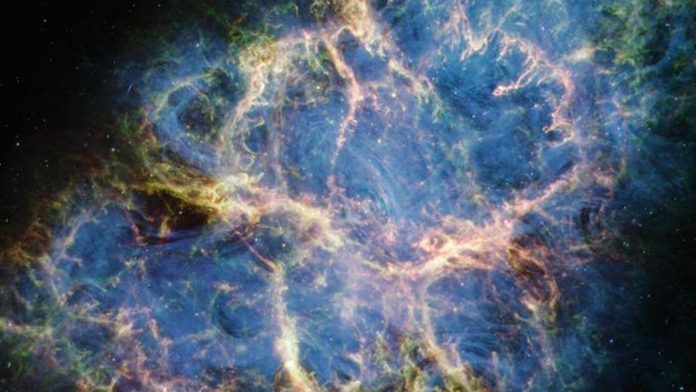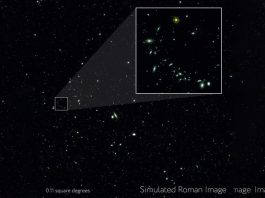A team of scientists used NASA’s James Webb Space Telescope to parse the composition of the Crab Nebula, a supernova remnant located 6,500 light-years away in the constellation Taurus.
With the telescope’s MIRI (Mid-Infrared Instrument) and NIRCam (Near-Infrared Camera), the team gathered data that is helping to clarify the Crab Nebula’s history.
The findings are published in a paper in The Astrophysical Journal Letters.
What is the Crab Nebula and why is it unusual?
The Crab Nebula is the result of a core-collapse supernova from the death of a massive star.
The much fainter remnant observed today is an expanding shell of gas and dust and outflowing wind powered by a pulsar, a rapidly spinning and highly magnetised neutron star.
Its atypical composition and very low explosion energy have previously been explained by an electron-capture supernova — a rare type of explosion that arises from a star with a less-evolved core made of oxygen, neon, and magnesium rather than a more typical iron core.
“The Webb data will widen the possible interpretation,” stated Tea Temim, lead author of the study.
“The composition of the gas no longer requires an electron-capture explosion, but could also be explained by a weak iron core-collapse supernova.”
Studying the present to understand the past
Past research efforts have calculated the total kinetic energy of the explosion based on the quantity and velocities of the present-day ejecta.
However, this theory does not agree with observations of the Crab Nebula, particularly the pulsar’s rapid motion.
In recent years, astronomers have also improved their understanding of iron core-collapse supernovae and now think that this type can also produce low-energy explosions, providing that the stellar mass is adequately low.
What did the Webb measurements reveal?
To lower the level of uncertainty surrounding the Crab’s progenitor star and the nature of the explosion, the team used Webb’s spectroscopic capabilities to study two areas located within the Crab’s inner filaments.
Theories predict that because of the different chemical composition of the core in an electron-capture supernova, the nickel to iron (Ni/Fe) abundance ratio should be much higher than the ratio measured in our Sun.
The Webb telescope, with its sensitive infrared capabilities, is now advancing Crab Nebula research. The team used MIRI’s spectroscopic abilities to measure the nickel and iron emission lines, resulting in a more reliable estimate of the Ni/Fe abundance ratio.
They found that the ratio was still elevated compared to the Sun, but only modestly and much lower in comparison to prior estimates.
Mapping Crab’s current state
Besides pulling spectral data from two small regions of the Crab Nebula’s interior to measure the abundance ratio, the telescope also observed the remnant’s broader environment to understand details of the synchrotron emission and the dust distribution.
The images and data collected by MIRI enabled the team to isolate the dust emission within the Crab and map it in high resolution for the first time.
“Where dust is seen in the Crab is interesting because it differs from other supernova remnants, like Cassiopeia A and Supernova 1987A,” said Nathan Smith, co-author of the paper.
He concluded: “In those objects, the dust is in the very centre. In the Crab, the dust is found in the dense filaments of the outer shell.”









